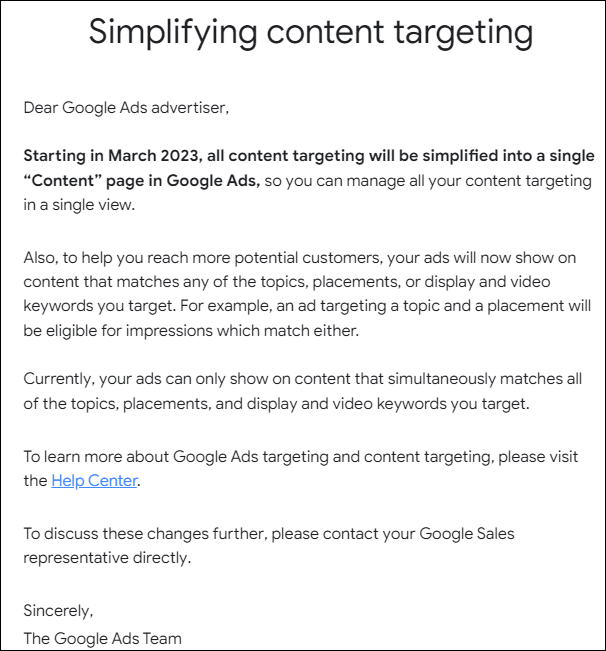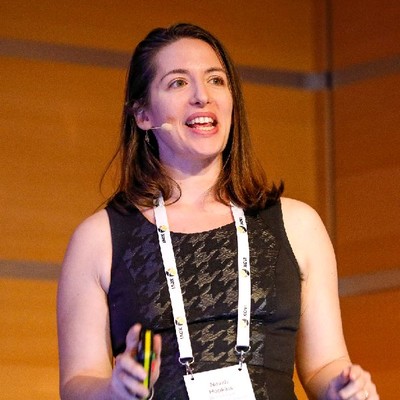Google recently announced that starting in March 2023, all content targeting will be simplified into a single “Content” page in Google Ads.

With this upcoming change in content targeting many advertisers are understandably concerned about what that will mean for their ROI. Up until 2023, Google advertisers would be able to make “or” and “and” statements with their content targeting.
This meant that brands could fine-tune their personas and really do innovative message mapping across the Google ad network.
Removing the “and” functionality means brands may need to forgo important types of placements that would otherwise be viable due to the grab-bag nature of the quality.
For example, a pet retailer might have used affinity targeting to ensure placements have to do with “pets”. This was a reasonable volume booster for display and video campaigns because they could layer other targeting parameters.
However, affinity audiences tend to be much looser and without the additional stipulations would likely drag the budget into unviable placements.
It’s been speculated that advertisers might pull their budgets from Google and use other ad channels with slightly more control. However, to regain the lost contextual targeting, advertisers would need to look to programmatic advertising.
We’re going to explore which ad channel is better suited to advertisers and how to make the most of each.
What is Programmatic Advertising?
Programmatic advertising is an automated way of advertising that leverages software involving algorithms to purchase online ad placements to target specific audiences and serve contextually relevant ads in real-time.
How is Programmatic Advertising different from Google Display Network (GDN)?
The core difference between programmatic advertising and GDN is that GDN is a self-contained network that can be accessed through programmatic bidding, but also has other softer signals; whereas programmatic advertising covers any data-backed, individual-based visual creative.
The most relevant programmatic advertising channels are:
- Display Ad Exchanges: Online hubs enabling brands to buy and sell ad impressions in real time.
Examples: Google AdX, AppNexus, and Rubicon Project.
Demand-Side Platforms (DSPs): DSPs are platforms allowing advertisers to purchase ad impressions from various sources, including display ad exchanges, in real time.
They equip advertisers to effectively target and bid profitably through data.
Examples: The Trade Desk, MediaMath, and LiveRamp.
Video Ad Networks: Video ad distribution platforms that specialize in reaching a robust network of websites and apps.
They connect advertisers to a large and engaged audience, and often offer advanced targeting capabilities, such as demographic and behavioral targeting.
Examples: TubeMogul and BrightRoll.
Social Media Platforms*: Social ad platforms are often overlooked in the programmatic conversation but are one of the most accessible channels.
While they don’t have the same levels of control and flexibility in targeting as they once did, they still represent far more robust targeting options than just the GDN.
Examples: Facebook, Instagram, Tiktok, and Pinterest.
Private Marketplaces (PMPs): PMPs are exclusive networks of premium publishers that offer programmatic access to their inventory.
They provide advertisers with a more controlled environment, compared to open exchanges.
Here are some general ranges for the cost of programmatic advertising:
Display Ads: There is no real difference in cost between programmatic and GDN on cost.
The auctions are fairly comparable, and while the methods of bidding are slightly different (CPM vs CPC vs Conversion), the core prices are not that different.
Auction prices will range from a few cents to several dollars and are determined by the competitiveness of the placement, as well as the floor bid the publisher is willing to accept.
Video Ads: This is where GDN and Youtube really shine. Programmatic plays tend to be more expensive with CPMs starting at $10 and ranging as high as $100.
The cost of video ads is driven by targeting strategy, quality, the exclusivity of the inventory being purchased, and ad format.
Social Media Ads: a big part of social ads is how many variables an advertiser wants to test (creative, audience, format, etc).
Placements are charged on both a CPC and CPM billing schedule depending on the bidding strategy and campaign goal. It’s normal to pay a bit less per view on social video channels than on Youtube, but the quality is a bit more grab bag.
Will Google Display Network still be viable for you post the targeting change?
It depends.
Some brands with exacting brand standards will force a move due to placement liabilities. For many brands, this change isn’t actually as big of a deal as other recent setting changes from Google.
At the end of the day, advertisers will still be able to choose placements and set exclusions.
The panic around GDN and its viability create an interesting opportunity for programmatic-first advertisers to test volume plays. Yes, they won’t have the ability to make “or” targeting choices, but with all the other tools at their disposal, there are some mighty bargains to be had.
One of the biggest wins for GDN is how self-serve it is. Brands who might have felt that they had to work through a rep to get their campaigns set up have the opportunity to capture new market share.
This change is ultimately just like how Google took away the ability to exclude mobile games from display campaigns.
How to protect your Google Display Network investment?
The most important thing you can do is make sure your placement exclusion list is in order. You can set rules in your account to begin capturing low-value placements to exclude, as well as placements you want to ensure get captured.
If you’re stuck or need help, Optmyzr’s Smart Exclusions tool can help you do this automatically.
You can read all about the Smart Exclusions tool here.
Another important step to consider is auditing your creative and confirming they translate to all personas your current placement eligibility represents. Non-programmatic advertisers can take a page from the programmatic handbook and begin thinking about each user and all the factors influencing their consideration.
While you are handing the real-time bidding to the Google algorithm, applying that level of segmentation on creative to audiences will improve your ROI.
Finally, consider testing your campaigns on the Microsoft Audience network (which is much cheaper than the GDN but behaves the same way) and prove which creative/audience types serve you best. Then take the winners to the GDN.
Final Thoughts
Ultimately the GDN continues to provide a lot of value for brands who need to increase their market share as well as recapture interest in warm leads. Adjusting for a looseness in placements is just as easy a change to account for as looseness in match types.
So long as brands are taking proactive measures to ensure their campaign structure is set up for success, the GDN will continue to provide value (if a bit more expensive than before).










